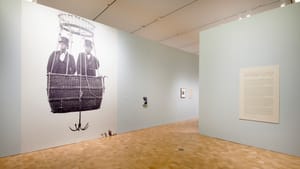Stay in the Loop
BSR publishes on a weekly schedule, with an email newsletter every Wednesday and Thursday morning. There’s no paywall, and subscribing is always free.
The world in one city
The Barnes Foundation presents Live and Life Will Give You Pictures (second review)

When the Barnes Foundation decides to mount its first-ever photography exhibition, you’d better believe it resonates loud and clear with their permanent collection.
Live and Life Will Give You Pictures: Masterworks of French Photography 1890-1950 is the largest exhibition to date of the vintage photography collection belonging to New York physicist Michael Mattis and his wife, Judy Hochberg. Organized around themes of modernity, we see the signs of industrialization, the advent of retail shopping, and changing gender roles. Most of all, we see the elegance and glamor of Paris contrasted with its gritty back alleys, brothels, soup kitchens, beggars, and thieves.
Documenting the feast
When Ilse Bing wasn’t shooting Schiaparelli perfume ads, she was documenting men reading Yiddish theater posters, street sweepers and Can-can dancers at the Moulin Rouge. Brassaï, whose work appeared in Harper’s Bazaar, prowled the streets of Paris at night, photographing streetwalkers and thugs. One of the most arresting images in the exhibition is Brassaï’s Two Toughs in Big Albert’s Gang (1931).
Although the exhibition spans the 1890s through the 1950s, its strength is during the 1930s when Eastern European immigrants and adventurous Americans poured into Paris. Ernest Hemingway arrived in 1921. So did So did Bernice Abbot, an American journalist who became Man Ray’s darkroom assistant, and after studying photography in Berlin, opened her own photography studio in Paris in 1927. Her photograph Hands of Jean Cocteau (1927) is one of the highlights of the show. Besides Cocteau, her subjects included James Joyce and photographer Eugene Atget.
At the time, Paris was, as Hemingway wrote, “a movable feast.” Yiddish, German and Spanish were heard in the cafes of Montparnasse where immigrant artists such as Modigliani, Chaim Soutine, and Marc Chagall congregated. These were the same cafes where photographers gathered, including Brassaï from Romania, Ilse Bing from Germany, André Kertesz from Hungary, and Man Ray (aka Emmanuel Radnitzky) from Philadelphia. This multicultural stew, which horrified the Paris art establishment (much as refugees are feared today), resulted in unprecedented creative collaborations (and bed hopping) between photographers, painters, and writers.
Gay Paree
One gets the feeling from this exhibition that 1930s Paris was as sexually liberated as Woodstock. Not just from the images of prostitutes, but from the revealing self-portraits and nudes shot by both male and female photographers. Take Dora Maar’s Nude with Mirror or Man Ray’s Lee Miller and Friend, which shows American photojournalist Lee Miller delivering a prelude to a kiss with an unidentified female.
Documenting “street life” also includes the bourgeoisie flaneurs and idle rich on the French Riviera. Lissette Model’s French Gambler, Nice (1934), shows a middle-aged gentleman attired in a business suit sunning himself on a promenade, his face bronzed more deeply than a certain presidential candidate. Update his suit a bit, and the photo could’ve been taken in Vegas last week.
Fans of Henri Cartier-Bresson will not be disappointed. Over 30 of his most famous images are included with images taken outside of France in Seville, Peking, Kashmir, Harlem, and Boston. If I could tuck just one photo under my arm, it would be Cartier-Bresson’s Behind the Gare Saint-Lazare (1932). Why? Because it’s a wonderful image with an even more wonderful story.
In 1945, it was believed Bresson died in a Nazi camp. Imagine the faces of the curators of a “memorial” exhibition of his work when the famous photographer appeared, alive and well. Bresson volunteered to contribute to the exhibition and, while sorting through his vast archives, came across a negative that contained a fabulous fragment. Although he never cropped his images, Bresson made an exception. The result is among his most famous photographs, a man jumping a puddle with his image reflected in the water below. It does what great photography is supposed to do. It captures a fleeting moment in time that is, amazingly, timeless.
To read Gary Day's review, click here.
What, When, Where
Live and Life Will Give You Pictures: Masterworks of French Photography, 1890-1950. Through Jan. 9, 2017 at the Barnes Foundation, 2025 Benjamin Franklin Parkway, Philadelphia. (215) 278-7000 or barnesfoundation.org.
Sign up for our newsletter
All of the week's new articles, all in one place. Sign up for the free weekly BSR newsletters, and don't miss a conversation.

 Stacia Friedman
Stacia Friedman